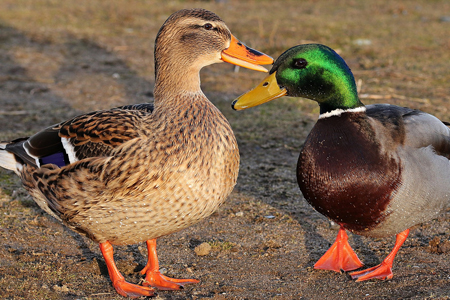
The color of a Mallard’s bill indicates its state of physical and reproductive health. Therefore, Mallard ducks can choose a healthy mate by assessing the drake’s bill color. Strange, but true. Here’s how it works:
Carotenoids and Free Radicals
Carotenoids influence the red, yellow, and orange hues of a duck’s feathers, skin, legs, and bill (and not incidentally, egg yolks). Carotenoids are plant pigments ducks and other animals cannot synthesize. They acquire these pigments from the plants they eat.
Carotenoids not only provide color, they are also powerful antioxidants that scavenge free radicals. Not to get too complicated, here, but free radicals are unpaired electrons. Since electrons like to be in pairs, an unpaired electron rummages around looking for a partner, meanwhile causing cell damage that leads to disease.
Free radicals concentrate in active organs, including those that make up the immune system, as well as the testes. These organs therefore benefit from high levels of free-radical scavenging antioxidants, such as carotenoids, which both stimulate the immune system and protect sperm.
A Mallard drake that has sufficient carotenoids to support his immune system (protecting him from diseases and parasites) and safeguard his sperm (ensuring good fertility), with enough left over to influence his bill color is a healthy drake, indeed.
Mate Selection
For two months of every year, a drake goes through what’s known as the eclipse molt. During this time, the drake takes on the drab brown plumage and bill color of a female Mallard. Following the eclipse molt, the drake resumes his usual color, known as nuptial plumage, and his bill color returns to yellow.
In the fall, following the molt, Mallards off for the spring breeding season. At this time, ducks gravitate toward drakes with the yellowest bills. Somehow, they know that drakes with the most colorful bills have the strongest immune systems and the healthiest sperm. But there’s more.
Antibacterial Sperm
Just like the digestive system, the reproductive system has a distinctive population of microbes consisting of bacteria, viruses, algae, protozoans, and fungi. Most of them are beneficial, but some are not so. Evolutionary ecologist Melissah Rowe and her colleagues have shown that this reproductive microbiome influences a drake’s sexual health and fertility. Not only that, but healthy Mallard drake sperm has anti-bacterial qualities.
And these antibacterial qualities influence the color of the drake’s bill. The more colorful a drake’s bill, the better his sperm is at killing bacteria. By assessing bill color, ducks can avoid mating with a drake that has sperm with a high bacterial count. Why is this important?
For two reasons. First, pathogenic bacteria can damage sperm and reduce the speed of sperm movement. Accordingly, one of the first signs of disease is reduced fertility.
Second, pathogens carried by a less healthy drake can be transmitted to a duck during breeding. Two of the more serious pathogens are Escherichia coli and Staphylococcus aureus. But both types of bacteria are susceptible to the antibacterial qualities of healthy drake semen.
Drake’s with more colorful bills have superior bacteria-killing semen. A Mallard duck therefore can protect herself from sexually transmitted infections, ensure fertility of her eggs, and assure a healthy daddy for her kids by choosing a mate based on the drake’s bill color.
And that’s today’s news from the Cackle Coop.
Gail Damerow is editor and principal author of Backyard Homestead Guide to Raising Farm Animals, which includes a chapter on ducks and geese.

